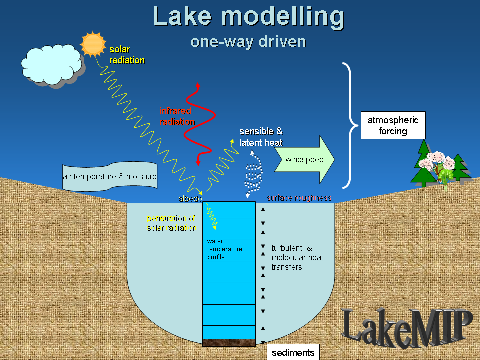EXPERIMENTAL SETUP_______________________________________________
MODEL EXPERIMENTS
The setup of model experiments should eliminate model discrepancies due to any source except the model physics. That means the initial and boundary condition at the lake-atmosphere interface must be the same for all models. In order to ensure this, and unifying some other setup parameters, the following conditions will be provided:
1) all models will use the same scheme for the computations of sensible, latent heat and momentum fluxes above the lake surface; this includes the parameterization of water surface roughness parameter and the usual scaling of the atmospheric forcing level.
2) the surface radiation parameters (shortwave and longwave albedos, longwave emissivity for water, ice and snow) will be identical
3) The initial profiles of temperature and other common variables of lake models will be provided by observations, if they exist; otherwise, the initial lake state will be generated individually by every model during the spinup
4) The unique lake depth for all models will be the depth in the point of observations
5) The strategy on vertical resolution of 1D models must be discussed

Download Fig.
We now have to choose the optimal scheme for surface fluxes. To resolve these, existing well tested surface schemes (e.g. the scheme, embedded in Flake model) will be compared with the data of flux observations above lakes. In this study the lake surface temperature will be provided by measurements. If it is then possible to identify the most suitable scheme, this would then be a potential candidate for subsequent LakeMIP experiments. Otherwise, the additional study will be performed to assess the sensitivity of the lake models results to the surface flux scheme.
Extra runs aiming at eliminating the errors caused by surface flux schemes will be to force lake models by measured turbulent and radiation fluxes. In these runs, the differences between measurements and models results will be only due to lake models physics and computational effects.
The atmospheric forcing issue will be examined as well. There are three possible sources of atmospheric forcing, ordered by increasing degree of errors of representation of the true meteorological conditions over a lake. These are:
1) measurements made over the lake water surface
2) measurements made at a "remote" meteorological station
3) atmospheric reanalysis data
Preferably the data (1) will be used. However, an additional study will be performed to estimate the discrepancy between model results with different kinds of atmospheric forcing (using the best flux scheme).
The detailed specification of the experimental setup for lakes models will by provided in the instructions for project participants.
____________________________________________________________________________

